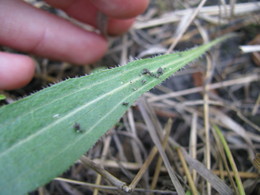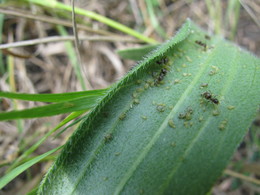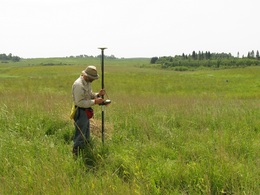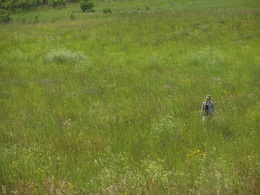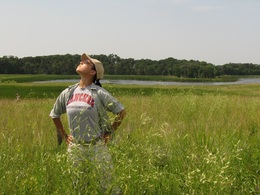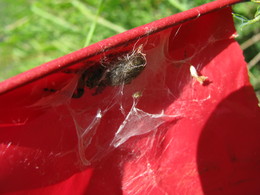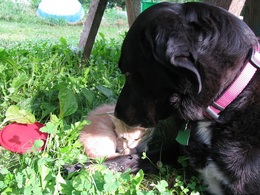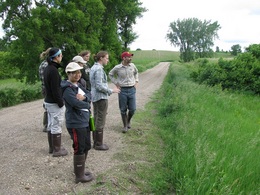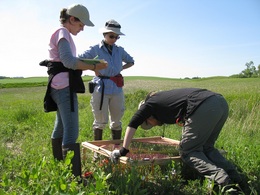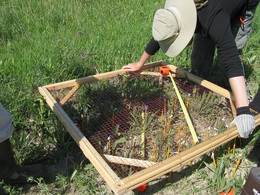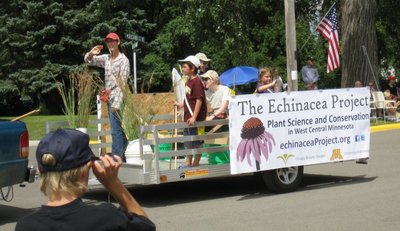|
|
Saturday brought a resurgence of the “not-so-bad” weather we’ve been enjoying this week. Several rainstorms have brought some much needed moisture to the soil. The reason I mention this is that while I worked on my aphid addition/exclusion experiment, I noticed a lot of dirt mounds on plants where aphids were present. Presumably, ants build these structures to cultivate aphids. Some of these were small, consisting of only a few small pieces, and some were large, taking up a large portion of a leaf. Here’s one of the smaller examples. The opposite side of the leaf was covered in aphids.

Here’s a picture of one of the plants in my aphid addition group. As you can see, the ants are taking full advantage of the situation:

As for other field work, Kelly spent the morning checking the status of flowers for her phenology study. Most of the remnants have stopped flowering, with the exception of one plant at a small remnant and many at the Staffanson prairie preserve. Because the west half of Staffanson was burned in May, Echinacea began blooming later than in the unburned half.
In the evening, we all gathered at the Wagenius family home for potluck dinner and bonfire. I should say bonfires, since there were two right next to each other. Pyromanic desires were fulfilled by all.
This past weekend a group of us went over to Glacial Lakes State Park for some hiking and a change of scenery (i.e. trees). During our hike we passed a few sections of remnant prairie, evident by the presence of lead plant (Amorpha canescens). One of these had what appeared to be a flowering Echinacea angustifolia. Due to a combination of curiosity and habit, I walked over to check the plant for aphids. Sure enough, there they were:

They looked like Aphis echinaceae, though they were slightly bigger than the aphids I’ve seen around here. The reason I mention this is that the specimens for Aphis echinaceae were collected in our field sites throughout Douglas County. Glacial Lakes State Park is a little under 30 miles away. I didn’t collect any aphids, but I thought it was an observation worth sharing.
Monday was quite sultry, if I remember correctly. In the morning we divided forces to look at flowering phenology in C1 and to finish measuring the plants in Amy Dykstra’s experiment at Hegg Lake. She has two experimental plots there: one containing the offspring of inter-remnant crosses and the other containing seeds collected from source populations between Minnesota and South Dakota. She sowed seeds in 2008 and has been tracking their progress every year since. Once we finished finding and measuring plants, Stuart took GPS points for each experimental plot:

While he was doing that, Shona trekked off into the prairie to check on the plants in her hybridization experiment.

Meanwhile, Lydia and I waited by the truck and took advantage of the opportunity for an epic pose. I’d say it was successfully epic.

After last week’s sultry weather, we’ve been enjoying a “dry heat”, as Greg Diersen so artfully put it. This morning everyone went their separate ways to pursue their individual projects:
Shona, Maria, and Lydia went directly to Hegg Lake and combined forces to measure plants and take GPS points. Shona also photographed Echinacea pallida and E. angustifolia plants as part of her project to assess species traits.
Andrew searched the main experimental plot (C1) for plants where he can observe pollinators. Because peak flowering has passed, his selection of flowering heads is growing slimmer by the day. Fortunately, he has some good observations under his belt and will be able to collect more before plants stop flowering.
Jill and Greg joined forces in operation pit-fall trap. Greg’s traps are bowls full of soapy water that he sets on the ground and leaves out for a couple of days. Jill’s are tubes full of propylene glycol that she submerges in the soil and leaves out for a week. Today, they set out Greg’s traps and collected from Jill’s. I have to say: the smell of dead insects stewing in propylene glycol for a week is probably one of the worst smells I have experienced.
I spent the morning removing aphids from plants in my aphid addition/exclusion experiment. Even though it has been three days since my last exclusion, there were aphids on 11 out of 50 plants in my exclusion group. One plant had 67 aphids–all in three days! Those aphids are moving and breeding fast.
This afternoon we joined together in our common goal of measuring every plant in C1. My mother used to say that the only way to eat an elephant is one bite at a time. Well, today we bit a big chunk off of our elephant, finishing up the sections planted in 1997, 1998, and 1999. We have less than half an elephant to go!
And now for a picture. In addition to helping us keep track of plants, pin flags make great habitat for spiders:

We were all having so much fun on the 4th of July that I forgot to write the events of the day.
Technically, the 4th of July is a day off for the Echinacea crew. Plants don’t celebrate national holidays, so we spent the morning assessing flowering phenology in the main experimental plot. After that, Andrew experienced a series of unfortunate events that kept him from observing pollinators. On the upside, he learned some valuable lessons and made a new friend.
Because aphids don’t take holidays either, I spent the latter part of the morning visiting plants in my aphid addition/exclusion experiment to remove aphids from the exclusion group. The goal of my experiment is to capture the effects of aphids in natural conditions–i.e. no cages or bags. That means that in order keep aphids off of the plants in the exclusion group, I need to visit them every few days to remove them by hand. For fifty plants (plus fifty more in the addition group) that’s a lot of footwork.
We celebrated America’s national holiday with a picnic at Elk Lake. We crammed in as many all-American activities as we could: potlucking, canoeing, sand-castle building, frying in the sun. If things weren’t American enough, Stuart brought a print-out of the Declaration of Independence, which we all took turns reading around the picnic blanket. Go America!
I didn’t get a good group picture, but here’s a cute shot of Jill, Shona, and Kelly:

Here are the day’s events:
When we arrived at work this morning we came upon a poignant scene. The Wagenius’ family dog, Roxie, had was nurturing an abandoned kitten:

I’m happy to say the poor creature has found a home with Kelly and her parents. Thanks to her loving care (and Roxie’s), it is now purring and mewling with gusto.
Once the kitty situation was resolved, we moved on to more serious business. Shona, Maria, Kelly, and Lydia spent the morning working on their individual projects while the rest of us assessed flowering phenology in two experimental plots (C1 and C2).
A lot of work goes into maintaining an experimental plot. In order to keep C1 from being overgrown by woody plants, several of us spent the afternoon trimming ash trees and sumac. The rest of us made progress on our individual projects. Thanks to help from Kelly and Lydia, Jill and I succeeded in setting up ant traps for all but one of our field sites. I’ll post more about that later.
Katherine here.
Most of the Echinacea crew arrived on Sunday. The week has gotten off to a running start. Here are some pictures from our first few days in action:



We made an Echinacea Project float and participated in the annual Harvest Festival Parade in Hoffman, MN. It was great fun!

This is how our float was announced… “Native prairies are very rare in Minnesota, but there are several prairie remnants in the Hoffman area. Every summer a team of scientists from around the country comes to study the biology, conservation, and restoration of prairie plants and insects. They are based in the Hoffman – Kensington area. If you see members of The Echinacea Project working on a hillside or in a ditch, ask them what they are doing!”

Team Echinacea is busy in two states! The Minnesota crew is working in the field and the dedicated crew of volunteers at Chicago Botanic Garden in Illinois is working in the lab. This panoramic image of the lab, taken by Bob Mueller, shows volunteers counting Echinacea seeds and taking random samples for weighing. Click & drag the image to see all 360 degrees!
Last week (well, 9 days ago), we headed north to the Crookston area to survey the Western Prairie Fringed Orchid (Platanthera praeclara).
View image
Gretel is showing everyone what to look for on the plant here.
View image
Katherine looks over the prairie
View image
An ant dangles on a thread of spider silk, threatened by the dangerous milkweed
View image
Here’s what we were actually looking for; the WPFO itself. We found over 1000 plants, way more than last year. All in all, a good day.
|
|

